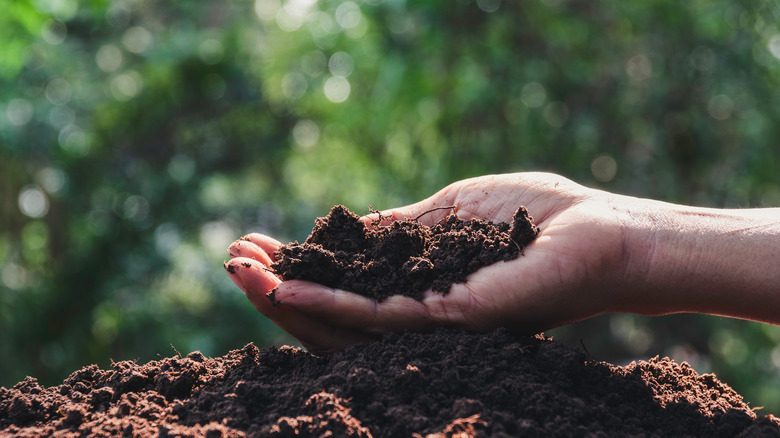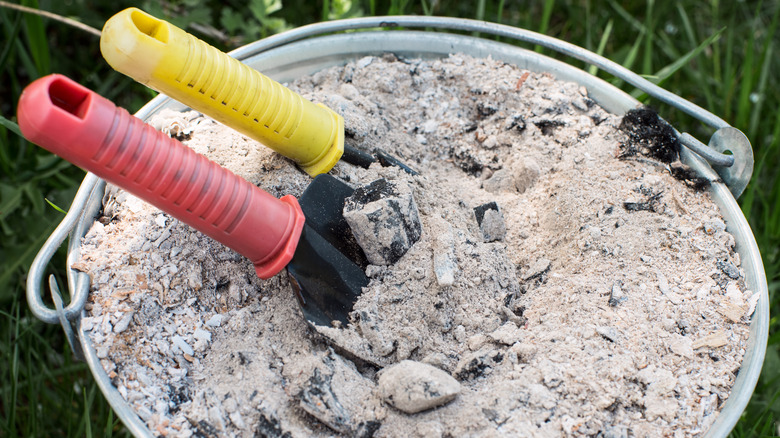Is Wood Ash Good For Garden Soil?
The ash that remains after burning wood has almost mystical properties — truly, like a phoenix. When conditions are right, wood ash can be added to soil, and from the pile of gray powder where embers once glowed, new life springs forth in the form of healthy blooms and bountiful, edible harvests. But will any wood ash suffice or, if not, where can this magical dust be found? According to Dian Farmer, it's important to choose ash only from natural wood burnings that haven't mingled with industrial chemicals either while growing as a tree or during its life in commercial applications.
Ash from chemically treated or painted wood will contain residual toxins that will leach into the soil and surrounding plants. Making clean, safe ash from unadulterated lumber for use in the garden can be an excellent DIY project simply by hosting a bonfire or enjoying a night by the fireplace and collecting the pile afterward. If this is not possible or you prefer to purchase wood ash, it's as easy as searching the internet and placing an order from an individual retailer.
When should wood ash not be used
As beneficial as wood ash can be for composting and growing plants, there are times when it can be harmful or unnecessary. One remarkable property of wood ash is that it contains a lot of calcium, which helps to increase the alkalinity of the soil. So, when it's added to a garden bed with a well-balanced or a high pH, growth problems occur. That's why the Michigan State University Extension recommends using ash only on soil with a pH lower than 6.5 (7.0 is neutral). The best way to know if your garden is a good candidate for its use is to perform a soil test to determine the pH level as well as the nutrient content.
Not all ash is the same. Be sure the ash you use is from actual wood and not charcoal (which contains harmful chemicals that will harm plants), recommends Cutting Edge Firewood. Hardwoods are brimming with much more nutrients than softwoods and make a better choice for garden use. Some plants, such as blueberries, rhododendrons, other greenery and trees, and especially potatoes, love a more acidic environment. Applying wood ash to their environment would increase the pH level and make it difficult for them to thrive while increasing the likelihood of their demise due to disease. Also, Dian Farmer recommends mixing the ash with the soil before planting because young leaves may be tender and could be damaged by coming into contact directly with the residue.
Benefits of using wood ash properly
Wood ash has many uses, including as fertilizer, compost aid, and lime alternative, according to GrowVeg. It increases calcium, potassium, and basic nutrient levels while deterring snails, slugs, and other little critters that destroy plants. It even makes the garden less inviting to bigger creatures like deer and rabbits. Ants aren't fond of it either, says Greenhouse Gutter. It raises the pH level of soil, aids in preventing disease in some plants, and can even help insulate plants a bit to prevent damage from cold weather and frost. Also, adding it to a lawn improves the look and health of the grass.
If the ash is from a fresh fire, wait until it is completely cooled to avoid personal injury as well as damage to plants, according to Cutting Edge Firewood. Most flowerbeds do well with just a thin layer sprinkled on top or mixed directly into the soil. Mixing it with water to create a sprayable liquid is another option. If possible, adding the ashes to the soil in fall and winter is best because it prepares the bed for new growth come spring. The wind easily carries ashes, and overuse and direct exposure to the powder can be dangerous for the eyes and lungs. Hence, it's important to wear protective goggles and a proper mask. With proper use, the benefits far outweigh the cons of using natural wood ash as a growing agent.


